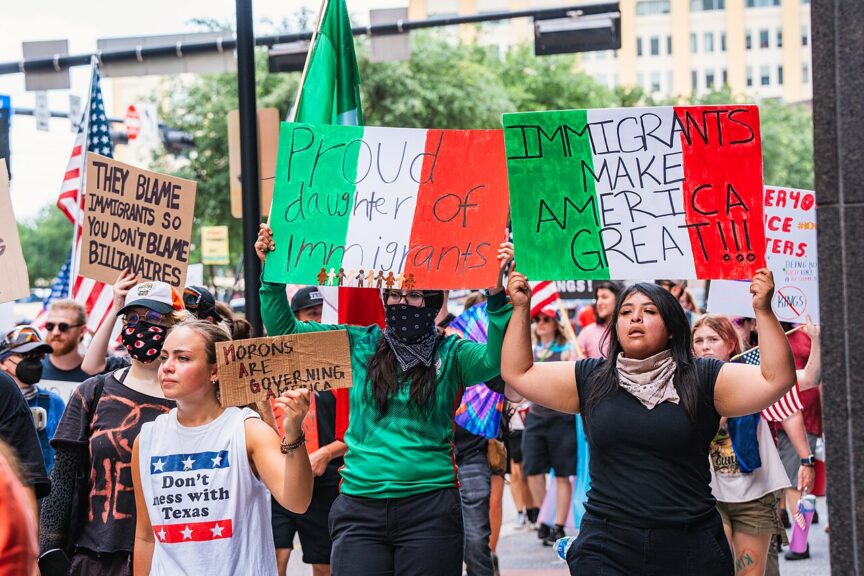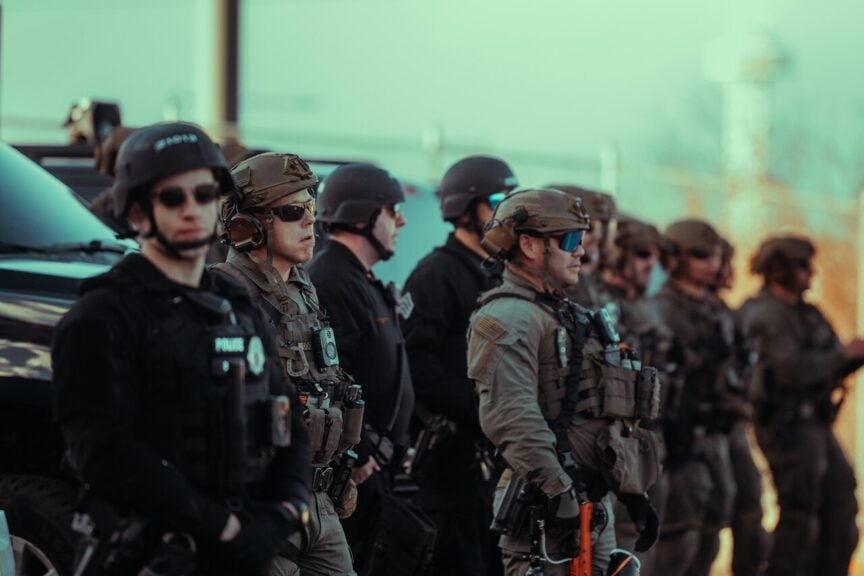This is the emotional story of life in America under authoritarian rule and martial law, painting a vivid picture of a society struggling to find its identity and its future. Through the lens of the everyday, we witness the struggles, resilience, and transformations that redefine the very fabric of American life.
Key Facts
While this is a fictional story, you’re still going to learn about authoritarian rule, martial law, and ICE: A secret police force as you read about the main character’s experience.
- Authoritarian rule refers to a governing system where individual freedoms are restricted, and the central authority maintains strict control over various aspects of life, often eliminating political dissent.
- Martial law typically involves the suspension of normal civil rights and the imposition of military authority, leading to curfews, increased police presence, and limited freedom of movement.
- Living under authoritarian regimes can lead to heightened anxiety, depression, and trauma, as individuals face a reality filled with fear and uncertainty.
- Communities can resist authoritarianism by organizing, amplifying marginalized voices, and engaging in grassroots activism to advocate for justice and equality.
- Personal stories humanize the struggles faced by communities, promoting empathy and solidarity, which are essential for mobilizing collective action in social movements.
A New Dawn
In the shadows of what was once a vibrant democracy, a new dawn breaks—a dawn shrouded in uncertainty and fear.
It was a crisp autumn morning when the first signs of change began to ripple through the streets of major cities. The sun cast long shadows across empty sidewalks, and the usual hum of morning activity was replaced by an eerie silence.
Neighborhoods that once echoed with laughter and conversation were now cloaked in a sense of foreboding. News outlets buzzed with reports of an election that had shifted the power dynamics of the nation, sparking debates around kitchen tables and in local cafes.
As the nation held its breath, the air thickened with tension. Social media timelines exploded with opinions, fears, and hopes. Yet, amid this chaos, a collective sentiment emerged: disbelief.
How had it come to this? How had the ideals of freedom and democracy become overshadowed by authoritarian rhetoric?
The atmosphere was electric, charged with the weight of a tangible fear that gripped the hearts of many.
The Main Character of Our Story
Amidst this turmoil, we meet our protagonist, a young woman named Serena. Once a spirited activist, she now found herself wrestling with the implications of the new regime. Serena had dedicated her life to advocating for social justice, championing the voices of the marginalized.
However, as the authoritarian leader rose to power, she felt her sense of purpose being challenged in ways she had never anticipated.
Serena’s experience reflects that of countless others who found their lives irrevocably changed. With each passing day, she observed her friends and family retreat into themselves, their dreams eclipsed by fear of the unknown.
What had once felt like an open future now seemed like a constricted path dominated by the omnipresent gaze of authority. Serena’s story becomes a poignant embodiment of resilience, echoing the struggles of many as they swim in the treacherous waters of life under an oppressive regime.
The Rise of an Authoritarian Leader

The story of America’s descent into authoritarian rule begins with the rise of a charismatic leader who promised to restore order and make America great again.
His campaign was marked by rhetoric that appealed to deep-seated fears and frustrations, painting a picture of a nation under siege from both internal (Democrats) and external (an “invasion” at America’s Southern border) threats.
As the new President was moving into the White House, the fervor of his supporters clashed with the resolve of his opponents, setting the stage for a deeply divided nation.
In speeches during the first 2 weeks of his second term, the new president vowed to prioritize national security, promising to crack down on crime and illegal immigration. His pledges resonated with a significant portion of the population who felt neglected by previous administrations.
However, what began as a call for safety quickly morphed into a narrative of xenophobia, control and repression. Dissenting voices were frequently silenced in the name of “unity.”
First 100 Days: A Rapid Transformation
The first 100 days of the new administration were nothing short of revolutionary—yet, not in the way many had hoped. Swiftly, executive orders began to reshape the legal and social landscape of the nation.
Laws that protected civil liberties were dismantled, and the boundaries of governmental power expanded to alarming degrees.
News cycles buzzed with reports of mass surveillance, the increased presence of a militarized secret police force, and the disbanding of essential watchdog organizations.
Serena watched in horror as her rights, and the rights of her fellow citizens, were eroded. The No Kings protesters that once filled the streets now faced violent crackdowns if they dared to speak out.
The government and legacy media painted these events (and protests against an active genocide in the Middle East) as threats to national security, branding dissenters as “enemies of the state.”
The vibrancy of democratic discourse was replaced with an atmosphere of fear and intimidation, stifling the very essence of what it meant to be an American. The First Amendment was no longer guaranteed by the U.S. Constitution.

Control Over Government and Institutions
As the months rolled on, the new administration tightened its grip on every sector of governance. Experienced professionals within the government were replaced with loyalists who shared the president’s vision and wouldn’t challenge the status quo.
The judiciary became increasingly politicized, and the conservative majority on the Supreme Court interpreted laws in ways that favored the administration’s agenda.
This pervasive control permeated institutions ranging from education to healthcare, reshaping policies to align with authoritarian principles.
Serena, once an outspoken advocate for change, now faced an uphill battle. The institutions that had served as pillars of democracy were now tools of oppression.
The realization that her voice, once powerful and resonant, was being drowned out by the machinery of state, left her feeling vulnerable and isolated.
A question loomed over her: how could ordinary citizens reclaim their voice in a system designed to silence them?
The Role of the Secret Police Force: ICE
In the wake of this authoritarian shift, the presence of a secret police force became a terrifying reality. ICE agents transformed from immigration enforcement officers into the new enforcers of state power.
Their presence was felt everywhere—from our neighborhoods to community centers—invoking fear and anxiety among everyday citizens. Serena’s own neighborhood saw an increase in these masked agents, their shadowy figures lurking in the background, representing the ever-tightening noose of oppression.
These agents were not just tasked with enforcing immigration laws; they had become symbols of an authoritarian regime. Reports of detentions without due process surged, and families were torn apart under the guise of national security.
Serena began to hear terrifying stories from her friends and neighbors—tales of loved ones disappearing in the night, of families living under constant threat. Each narrative reinforced the chilling reality: the state was watching, and inaction was not an option.

Imagine, if you will, the sight of these agents: clad in tactical gear, faces obscured by fabric masks, they stand in the shadows of open streets. Their presence is a stark reminder of the new order.
With intimidating postures and swift movements, they project authority and fear. The community becomes a backdrop for their operations, turning once-safe spaces into zones of anxiety.
Serena often found herself glancing over her shoulder, a palpable tension in the air as she moved through her daily life.
The transformation of public spaces into arenas of surveillance marked a major shift in the American psyche.
The once vibrant neighborhoods, filled with the sounds of children playing and families gathering, now felt like prisons, where freedom of movement was constrained by an ever-watchful eye.
This visual reality served as a constant reminder of the fragility of liberty under authoritarian rule.
Mass Deportations: Stories from the Ground
The specter of mass deportations loomed large over communities across the nation. Families who had lived in the U.S. for decades found themselves facing the grim reality of being uprooted from the only home they knew.
Serena’s heart ached as she witnessed the impact of the government’s actions. Personal stories flooded her community—tales of children left without parents, businesses shuttered, and neighborhoods stripped of cultural richness.

These deportations were not just statistics; they were lives disrupted, dreams shattered.
Serena learned of a young couple, immigrants from Central America, who had built a life in their neighborhood, only to have it torn apart in a matter of hours.
Their story echoed throughout the community, a haunting reminder of the cost of authoritarianism. As Serena listened to these stories, she realized that the heart of the struggle lay not just in resisting oppression but in amplifying the voices of those affected.
Life Under Martial Law
As martial law became the new norm, everyday life was dramatically transformed. Serena’s once carefree daily routine was now punctuated by fear and uncertainty.
Curfews restricted movement, and checkpoints dotted the city, manned by members of the President’s secret police force. What used to be simple errands now required careful planning, as the risk of encountering authority lingered at every corner.
With each passing day, communities adapted to this new reality, creating informal networks to share information and support one another. Serena joined a group of activists who met in secret, strategizing ways to resist the pervasive grip of martial law.
These gatherings became a lifeline, a place where voices were heard, and the spirit of resistance ignited. The camaraderie forged in these moments reminded Serena that she was not alone in her struggle, and that hope could still flourish amid despair.
Community Reactions and Resistance
The fear of martial law did not silence the voices of the people; rather, it galvanized a movement. Communities began to organize quietly, forming coalitions to share resources and support those most affected by the regime’s policies.
Serena attended clandestine meetings where plans were hatched to distribute food to families in need and to provide shelter to those facing deportation.
In one heartwarming instance, a local artist painted a mural that depicted the vibrant history of the community, a powerful statement against the erasure of culture and identity. This act of defiance resonated deeply, breathing life into the spirit of resistance.
Serena’s heart swelled with pride as she witnessed the resilience of her community, reminding her that even in the darkest times, hope could be found in the unyielding spirit of the people.
Personal Stories of Fear and Courage
Amid the backdrop of martial law, personal stories emerged as powerful testaments to the human spirit. Serena met Maria, a single mother who had fled violence in her home country and built a new life in America.
Maria’s courage was evident as she shared her story of escape, and her determination to protect her children at all costs. This connection ignited a spark within Serena—one that fueled her commitment to advocate for those whose stories often went unheard.
Every story shared in those secret meetings reinforced the harsh realities of life under an authoritarian regime. Serena listened intently as individuals talked about encounters with the secret police force, their dreams for a better future overshadowed by the constant threat of violence.
Yet, among the fear, were glimmers of courage—moments when individuals stood up against injustice, reminding Serena resistance wasn’t just about grand gestures; it was also found in the quiet acts of defiance that shaped a shared narrative.
The Emotional Toll
The emotional toll of living under authoritarian rule and martial law extended deep into the heart of families and relationships. The strain of constant fear and uncertainty eroded the bonds that once held communities together.
Serena observed her friends withdrawing, their laughter replaced by hushed conversations and anxious glances. Families were torn apart, not just physically through deportations but emotionally as well, as the weight of oppression suffocated their spirit.
Serena’s relationship with her own family also shifted dramatically. Conversations that once revolved around dreams and aspirations turned into discussions marked by caution and dread.
Joyous gatherings were now overshadowed by the looming threat of violence or separation from the secret police force. This emotional distance became a prevailing reality, manifesting itself in sleepless nights and whispered fears.
Serena longed for the days when hope felt abundant, but the darkness of authoritarianism cast a shadow over their lives.
Psychological Effects of Living in Fear
As the regime entrenched its power, the psychological effects of living under constant surveillance became increasingly evident. Serena began to notice changes in herself and those around her—anxiety, depression, a pervasive sense of hopelessness.
The uncertainty of the future weighed heavily on her heart, and she felt a growing sense of isolation as fear clouded the joy of connection.
The normalization of fear bred a generation marked by trauma. Serena attended support groups where individuals shared their struggles, revealing the deep impact of living under oppression.
The anecdotes varied, but the underlying theme remained the same: the emotional toll was staggering. Yet, within these circles of vulnerability, Serena found solace—an understanding that while the regime sought to divide and conquer, the power of collective healing could bridge the gaps of despair.
Hope and Resilience Amidst Oppression
Despite the emotional turmoil, Serena discovered that hope and resilience remained intertwined within the human spirit. She began to hear stories of individuals who turned their pain into purpose, cultivating gardens of resistance where despair once reigned.
Activists organized community events, creating safe spaces for dialogue and solidarity, reminding each other that they were stronger together.
In moments of darkness, Serena found inspiration in stories of triumph over adversity. The resilience of those around her became a beacon of hope, illuminating the path toward change.
As she participated in grassroots efforts to advocate for justice and equality, Serena felt a renewed sense of purpose.
She realized that while the struggle was demoralizing, the collective voice of the people could not be silenced.
As Serena’s journey unfolds, it becomes evident that the fight for freedom and democracy is far from over. The landscape of America may have changed, but the spirit of its people remains unyielding.
The stories shared, the connections forged, and the resilience displayed are testaments to the enduring power of hope. Serena’s story reveals the essence of a society wrestling with its identity, struggling to reclaim the ideals that once defined it.
In the face of authoritarianism, collective action is necessary. As Serena learns, the strength of a community lies in its ability to stand together against oppression.
The power of unity can challenge the status quo and pave the way for a brighter future. By amplifying marginalized voices and sharing stories of resilience, individuals can contribute to the greater narrative of change.
Each act of defiance, no matter how small, contributes to the larger tapestry of resistance.
As Serena reflected on her experiences, she emerged with a renewed sense of purpose. The future may be uncertain, but the spirit of the people is indestructible.
The story of America under authoritarian rule is one of struggle, but it’s also a story of resilience, hope, and the unwavering pursuit of justice. Serena’s journey serves as a reminder that even in the darkest times, the light of humanity can shine through, illuminating paths toward a better tomorrow.
Questions you may have after reading this story
Answers to these questions appeared in the key facts box at the beginning of the story.
What does authoritarian rule mean?
Authoritarian rule refers to a governing system where individual freedoms are restricted, and the central authority maintains strict control over various aspects of life, often eliminating political dissent.
How does martial law affect daily life?
Martial law typically involves the suspension of normal civil rights and the imposition of military authority, leading to curfews, increased police presence, and limited freedom of movement.
What are the psychological impacts of living under authoritarian regimes?
Living under authoritarian regimes can lead to heightened anxiety, depression, and trauma, as individuals navigate a reality filled with fear and uncertainty.
How can communities resist authoritarianism?
Communities can resist authoritarianism by organizing, amplifying marginalized voices, and engaging in grassroots activism to advocate for justice and equality.
What role do personal stories play in social movements?
Personal stories humanize the struggles faced by communities, fostering empathy and solidarity, which are vital for mobilizing collective action in social movements.




 Climate | Energy
Climate | Energy
 Gov | Politics
Gov | Politics
 Health
Health
